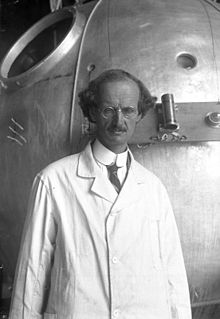Auguste Piccard
Auguste Piccard (born January 28, 1884 in Basel , † March 24, 1962 in Lausanne ) was a Swiss scientist, physicist ( experimental physics ) and inventor . He is the twin brother of the chemist Jean-Felix Piccard and father of Jacques Piccard . The psychiatrist and balloonist Bertrand Piccard is his grandson.
Life

Piccard graduated from the Polytechnic in Zurich (later the ETH) in 1910 as a mechanical engineer , followed by his doctorate in 1913. In 1915 Piccard became a private lecturer, in 1917 he received a professorship for mechanics and from 1920 for physics at the ETH. In 1922 he was appointed to the University of Brussels , where Piccard taught until his retirement in 1954. In addition to his groundbreaking stratospheric experiments, Piccard also dealt with atomic physics . In 1917 he predicted the existence of a third isotope of uranium, which he called actinuran. This was discovered by Arthur Jeffrey Dempster in 1937 and identified as uranium-235 . Among other things, Piccard constructed the most accurate seismograph at the time .
Stratospheric Research

From Augsburg started from, presented Piccard and his assistant Paul Kipfer on May 27, 1931 aboard the FNRS-1 a balloon -Höhenrekord of 15,785 m.
An important motivation for Piccard's ascent into the upper atmosphere was the possibility of measuring cosmic radiation there. Piccard wanted to collect experimental evidence for the theories of his friend Albert Einstein . Like Piccard, Einstein had studied at ETH. They met at the legendary 5th Solvay Conference in 1927, which brought together all the then important physicists of the theory of relativity, atomic and quantum physics. Piccard's balloon flights were theoretically prepared in collaboration with Albert Einstein and were actually able to successfully prove part of the special theory of relativity experimentally.
On August 18, 1932, Auguste Piccard and the Belgian physicist Max Cosyns (1906–1998) rose for the second time in a gas balloon , this time from Dübendorf in Switzerland. They set a new world record with 16,940 meters ( geometric measurement , barometric 16,201 meters), which was later increased to 23,000 m.
After the Second World War he developed the bathyscaphe ( FNRS-2 and Trieste ), a type of submarine for exploring the deep sea. On September 30, 1953, Piccard set a new record with the Trieste when he dived in the Tyrrhenian Sea , accompanied by his son Jacques Piccard, to a depth of 3,150 meters. The aim of this dive was to explore deep sea life.
Eponyms
The mesoscaph Auguste Piccard (PX-8) is named after Piccard and dived with tourists in Lake Geneva at the Swiss National Exhibition in Lausanne in 1964 .
Likewise, in 1960 the Bay Piccard Cove in Antarctica and in 2002 the asteroid (43806) Augustepiccard were named after him.
Piccard as a literary figure
Auguste Piccard is the inspiration for the character Professor Bienlein (French Prof. Tournesol , English Prof. Calculus ) in the comic series Tintin . Its creator, Hergé , met Piccard as a pupil in Brussels, where every child knew the Swiss professor with his impressive height and striking appearance (tangled hair, stiff collar). While the fictional Professor Bienlein flew to the moon with a self-made nuclear rocket, the real Piccard described Wernher von Braun's plans to fly to the moon as a “dangerous utopia” shortly before his death .
Adrian Leverkühn's story about an underwater expedition in Thomas Mann's Doctor Faustus may also go back to reports about Piccard's experiments. Piccard's stratospheric flight from 1931, which ended with an emergency landing on Gurgler Ferner , is the subject of Norbert Gstrein's novella O 2 from 1993.
Fonts
- Above the clouds, beneath the waves. Brockhaus, 1954.
literature
- Susanne Dieminger, Roland Jeanneret : Piccard: Pioneers without borders. With a foreword by Richard Branson . Weltbild, Olten 2014, ISBN 978-3-03812-517-4 .
- E. Stahel: Auguste Picarrd , Swiss Society for Natural Research, Vol. 142, 1962, pp. 223-227
Web links
- Literature by and about Auguste Piccard in the catalog of the German National Library
- Newspaper article about Auguste Piccard in the 20th century press kit of the ZBW - Leibniz Information Center for Economics .
- Jean-François Rubin: Piccard, Auguste. In: Historical Lexicon of Switzerland .
- Piccard monument in Obergurgl
- Videos of the three generations of Piccard on Swiss television (some in German, French or Italian)
Individual evidence
- ^ A. Hermann: The mother isotope of nuclear fission 235 U - 50 years . In: Isotopenpraxis Isotopes in Environmental and Health Studies . tape 21 , no. 7 , 1985, pp. 237-240 , doi : 10.1080 / 10256018508623501 .
- ↑ The Explorer Gene: How Three Generations of One Family Went Higher, Deeper ... - Tom Cheshire - Google Books. In: books.google.c. Retrieved April 3, 2014 .
- ↑ H. Voelkle: The cosmic radiation. Bull. Soc. Frib. Sc. Nat. Vol. 100 (2010) p. 1 (PDF; 3.4 MB)
- ↑ a b Obituary Piccard: DER SPIEGEL, 14/1962
- ↑ Erich Tilgenkamp: Journeys in unusual spaces. An authorized biography. New Life Publishing House, Berlin 1956.
| personal data | |
|---|---|
| SURNAME | Piccard, Auguste |
| BRIEF DESCRIPTION | Swiss scientist, physicist and inventor |
| DATE OF BIRTH | January 28, 1884 |
| PLACE OF BIRTH | Basel |
| DATE OF DEATH | March 24, 1962 |
| Place of death | Lausanne |
